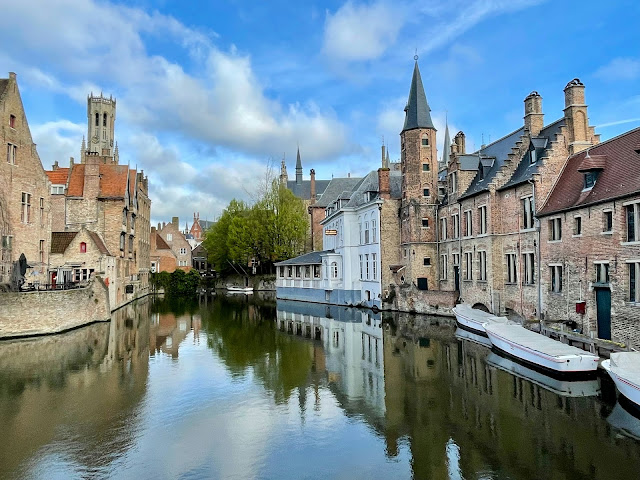Discovering the Beauty and Charm of Costa Brava: A Travel Guide
Costa Brava is a stunning region of Catalonia, Spain, that stretches from the French border to the city of Blanes. It is famous for its rugged coastline, sandy beaches, charming villages, and rich cultural heritage. Whether you are looking for adventure, relaxation, or inspiration, Costa Brava has something for everyone.
 |
| Tossa de Mar, Costa Brava, Spain |
Things To Do in Costa Brava, Spain
- Hike the Camí de Ronda
The Camí de Ronda is a network of coastal paths that connect the towns and villages of Costa Brava. It offers spectacular views of the Mediterranean Sea, cliffs, coves, and forests. You can hike along different sections of the trail, depending on your fitness level and time availability. Some of the most popular routes are from Lloret de Mar to Tossa de Mar, from Calella de Palafrugell to Llafranc, and from Roses to Cadaqués.
- Find a hidden cove
Costa Brava is home to hundreds of coves and bays that offer secluded spots for swimming, sunbathing, and snorkeling. Some of them are accessible by car or foot, while others require a boat or kayak. Some of the most beautiful coves are Cala Montjoi, Cala Sa Tuna, Cala Sant Roc, Cala Pola, and Cala Giverola.
- Explore picturesque villages
Costa Brava has many charming villages that preserve their medieval architecture, cobblestone streets, and local traditions. You can visit them by car, bus, or bike, and enjoy their history, culture, and gastronomy. Some of the most enchanting villages are Pals, Peratallada, Besalú, Cadaqués, and Tossa de Mar.
- Stroll around the narrow streets of Costa Brava’s capital: Girona
Girona is a vibrant city that combines ancient history with modern amenities. It has a well-preserved old town that features a Gothic cathedral, a Jewish quarter, a Roman wall, and colorful houses along the Onyar river. You can also visit its museums, art galleries, markets, and festivals. Girona is also a great base for exploring other attractions in Costa Brava, such as the Dali Museum in Figueres or the volcanic area of La Garrotxa.
- Discover underwater treasures
Costa Brava is a paradise for divers and snorkelers who want to explore its rich marine life and underwater landscapes. You can find coral reefs, caves, shipwrecks, and a variety of fish and plants. Some of the best diving spots are Cap de Creus Natural Park, Medes Islands Marine Reserve, Montgrí Natural Park, and Banyoles Lake.
- Sample local cuisine: tapas and fresh seafood
Costa Brava is known for its delicious cuisine that reflects its Mediterranean identity and influences from neighboring regions. You can taste its specialties in its restaurants, bars, and markets. Some of the dishes you should try are paella (rice with seafood), fideuà (noodles with seafood), suquet de peix (fish stew), escalivada (roasted vegetables), botifarra (sausage), crema catalana (custard dessert), and cava (sparkling wine).
- Watch the sunrise over the Mediterranean sea
One of the most magical experiences you can have in Costa Brava is watching the sunrise over the sea from one of its viewpoints or beaches. You can admire the changing colors of the sky and water as you listen to the sound of the waves and birds. Some of the best places to enjoy this spectacle are Cap de Creus lighthouse, Sant Pere de Rodes monastery, Aiguablava beach, Sa Conca beach, and Santa Cristina beach.
Visit the Salvador Dalí Museum in Figueres
The Salvador Dalí Museum is located in the town of Figueres, and it houses the largest collection of works by the famous surrealist artist. The museum itself is a work of art, designed by Dalí himself, and features a wide variety of sculptures, paintings, and installations that showcase his creative genius.
Relax on the beaches
Costa Brava is known for its beautiful beaches, and there are plenty to choose from. Some of the most popular beaches include Platja d'Aro, Lloret de Mar, Tossa de Mar, and Calella de Palafrugell. Whether you prefer sandy or pebbly beaches, crowded or secluded ones, there is a beach for everyone in Costa Brava.
Visit the medieval castle of Begur
The castle of Begur is a medieval fortress located on top of a hill overlooking the town of Begur. It dates back to the 11th century and has been well-preserved over the centuries. Visitors can explore the castle's various towers, walls, and courtyards, and enjoy stunning views of the surrounding countryside and coastline.
Go kayaking or paddle-boarding
Kayaking and paddle-boarding are popular activities in Costa Brava, and there are plenty of opportunities to try them out. You can rent a kayak or paddle-board and explore the coves and bays along the coast, or take a guided tour to discover hidden spots and learn about the local flora and fauna.
Explore the Cap de Creus Natural Park
Cap de Creus is a stunning natural park located at the easternmost point of Spain. It features rugged cliffs, crystal-clear waters, pristine beaches, and a variety of plant and animal species. You can hike along its trails, swim in its coves, and admire its breathtaking scenery.
Attend a music or cultural festival
Costa Brava is home to many music and cultural festivals throughout the year. Some of the most popular ones include the Cap Roig Festival in Calella de Palafrugell, the Porta Ferrada Festival in Sant Feliu de Guíxols, and the Festival Internacional de Música de Cadaqués. These festivals offer a great opportunity to experience the local culture and enjoy live performances by international artists.
Visit the Roman ruins of Empúries
The Roman ruins of Empúries are located near the town of L'Escala and date back to the 6th century BC. They include an ancient Greek settlement and a Roman city, and offer a fascinating glimpse into the region's ancient history. Visitors can explore the ruins and learn about the daily life of the settlers through guided tours and interactive exhibits.
Take a hot air balloon ride
For a truly unforgettable experience, you can take a hot air balloon ride over Costa Brava. You'll soar above the coastline and the countryside, enjoying panoramic views of the mountains, the sea, and the picturesque villages below. It's a unique way to experience the beauty of Costa Brava from a different perspective.
What is Costa Brava famous for?
Costa Brava is famous for its beautiful coastline, with crystal-clear waters and rocky cliffs. The region is also known for its charming villages, such as Cadaqués and Tossa de Mar, which have preserved their medieval architecture and traditions. Costa Brava is home to many beautiful beaches, including sandy and secluded coves, as well as rugged and wild stretches of coast.
The area is also famous for its seafood cuisine, particularly dishes like paella and fideuà, which feature fresh seafood caught in the local waters. Additionally, Costa Brava is home to the Salvador Dalí Museum in Figueres, which houses the largest collection of works by the surrealist artist.
Costa Brava Nightlife
Costa Brava has a vibrant nightlife scene, with many bars, clubs, and pubs that stay open late into the night. Lloret de Mar is one of the most popular destinations for nightlife on Costa Brava, with its numerous bars and clubs catering to a young and lively crowd. Tossa de Mar is another popular nightlife spot, with its beachfront bars and clubs offering live music and DJs playing a variety of genres.
Other towns and cities, such as Girona and Platja d'Aro, also have a wide range of bars and clubs that cater to different tastes and styles. Overall, Costa Brava's nightlife offers something for everyone, whether you're looking for a laid-back bar or a high-energy club experience.
What is the most charming village Costa Brava?
Costa Brava has many charming villages, each with its own unique character and attractions. It is difficult to single out a "most charming" village as it depends on personal preferences. However, some of the most enchanting villages in Costa Brava include:
- Cadaqués - a picturesque fishing village that inspired artists such as Salvador Dalí and Pablo Picasso.
- Tossa de Mar - a medieval town surrounded by ancient walls and towers overlooking a beautiful bay.
- Pals - a well-preserved medieval village with narrow streets, stone houses, and Gothic architecture.
- Peratallada - a tiny village with cobbled streets, arches, and a castle that dates back to the 10th century.
- Begur - a hilltop village with beautiful views of the coast, a medieval castle, and a variety of beaches and coves nearby.
These villages offer visitors a glimpse into the region's rich history, culture, and natural beauty, making them all worth a visit.
FAQs:
What is the best time of year to visit Costa Brava?
The best time to visit Costa Brava is from May to September, when the weather is warm and sunny, and most attractions are open. However, peak season can also be quite crowded and expensive, so consider visiting in late spring or early fall for fewer crowds and lower prices.
How do I get around Costa Brava?
Costa Brava is well-connected by public transportation, with buses and trains connecting major towns and cities. Renting a car is also a popular option, as it allows you to explore more remote areas at your own pace. Additionally, cycling and hiking are great ways to discover the region's natural beauty and charming villages.
What are some must-see attractions in Costa Brava?
Some of the must-see attractions in Costa Brava include the Salvador Dalí Museum in Figueres, the medieval castle of Begur, the Roman ruins of Empúries, and the picturesque villages of Cadaqués, Tossa de Mar, and Pals. The region is also known for its beautiful beaches, such as Platja d'Aro, Lloret de Mar, and Calella de Palafrugell.
What is the local cuisine like in Costa Brava?
The local cuisine in Costa Brava is Mediterranean-inspired, with a focus on fresh seafood, vegetables, and olive oil. Some popular dishes include paella, fideuà, suquet de peix, escalivada, and botifarra. Additionally, the region produces its own sparkling wine, called cava, which is perfect for toasting to a wonderful vacation.



Comments
Post a Comment
It's easy to leave a comment on our blog – anyone with a Google account can do it. We invite you to share your experiences by leaving a comment as well.